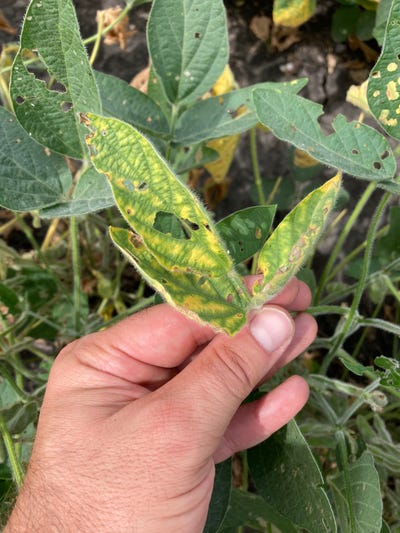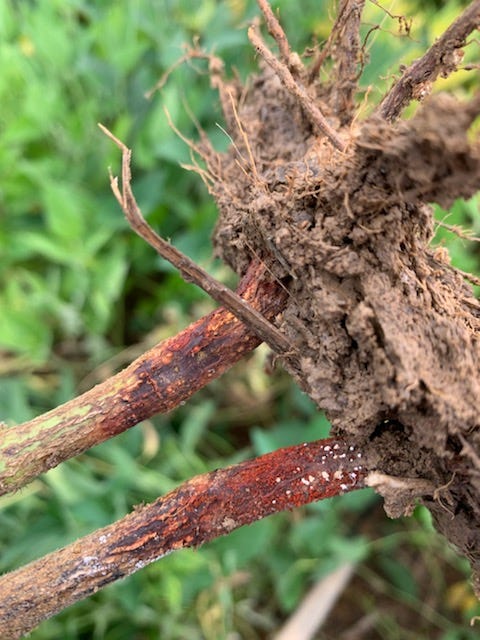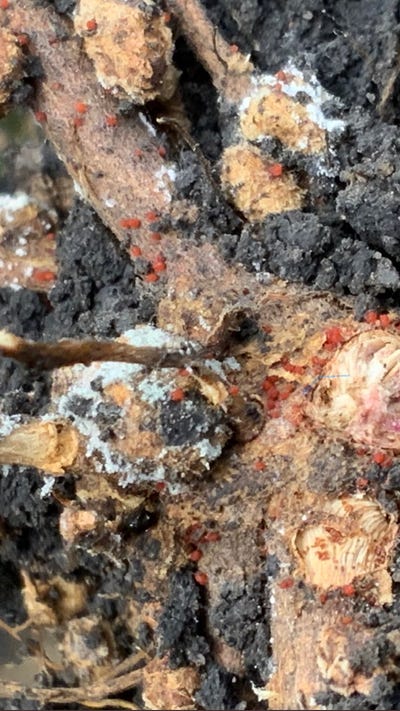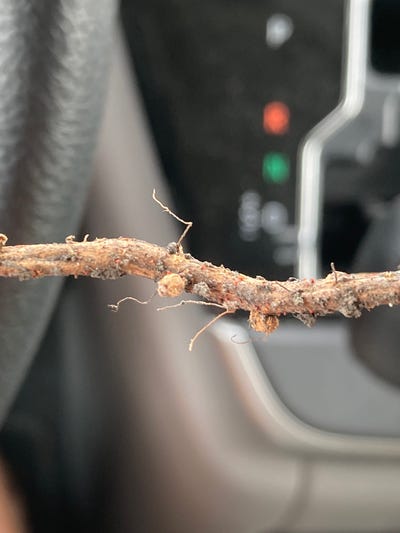September 8, 2020

Red crown rot is a new disease in the Midwest, and was first detected in 2017 in a single field in Pike county Illinois. The fungal disease is soil-borne and causes a root/crown rot following wet conditions near planting. Later in the season, typically after R3, the fungus can produce a toxin that moves into the foliage. This toxin accumulates in the leaves, killing the tissues and leaves over time. Severely affected plants die or senesce prematurely, with the leaves staying attached to the plant. The important thing to note is that there are several diseases and issues that can cause similar symptoms, so drive by scouting is not sufficient, and you’ll need to go out into the field and inspect several plants.

One symptom of RCR is interveinal necrosis/chlorosis. This is caused by accumulation of a toxin in the foliage. Several other diseases can cause this symptom, such as SDS, Brown stem rot, and even southern stem canker.

More advanced interveinal chlorosis
Once you see interveinal chlorosis, the next step is to look for plants that are more advanced in terms of disease. Inspect the crown and stems of these plants. If conditions have been wet, you may see small round, brick red “balls” on the lower stem. You also may see the lower stem covered by white fungal growth. The key here is the presence of fungal tissues, not simply a reddish coloration to the stem. Several factors can cause a reddish tint to lower stems, so just because you see a reddish color on your stems does not mean you have Red crown rot.

Red crown rot can sometimes be observed on the lower stems near the soil line. Look for small, pinhead sized brick red balls. A hand lens is helpful for this purpose.
If conditions have been dry recently, the fungus may not be able to produce the red structures on the stem. The next step is carefully removing the plant from the ground with a shovel, and gently knocking off soil adhering the roots. The Red crown rot fungus will produce those same red balls on the roots and crown, just under the soil line. You may need to pull up several plants before seeing these structures.

Red “balls” on the lower crown of a soybean affected by red crown rot. Note the blue growth- that’s the causal fungus of Sudden Death Syndrome. Remember that co-infection can occur, so don’t assume anything is RCR or SDS without checking those stems and roots!

Currently we are working to better understand the distribution and management of Red Crown Rot in Illinois. If you have plants with interveinal chlorosis, or suspect red crown rot, collect several lower stems and roots and place them in a cooler in a one gallon ziplock bag. Do not include the upper foliage and stems. Keep samples in a fridge until they can be shipped, but try to send within 4-5 days. Please send several roots and stems overnight, Monday-Wednesday to: Kleczewski Lab- RCR Survey. 064 NSRL, University of Illinois, 1101 W Peabody Drive Urbana Illinois 61802. On each bag include the date, county, coordinates, % field affected, and previous crop, as well as a contact email or number. The student conducting this work will summarize the 2020 survey later in the fall and provide results to participants in the early winter. Please be patient, as this is part of a student project and will require time to ensure that quality data are being generated for you.
Source: University of Illinois Extension, which is solely responsible for the information provided and is wholly owned by the source. Informa Business Media and all its subsidiaries are not responsible for any of the content contained in this information asset.
You May Also Like




